+ Open data
Open data
- Basic information
Basic information
| Entry | Database: EMDB / ID: EMD-6788 | |||||||||
|---|---|---|---|---|---|---|---|---|---|---|
| Title | Small subunit of Trichomonas vaginalis ribosome | |||||||||
 Map data Map data | ||||||||||
 Sample Sample |
| |||||||||
 Keywords Keywords | Trichomonas vaginalis ribosome / rRNA / rprotein / RIBOSOME | |||||||||
| Function / homology |  Function and homology information Function and homology informationnegative regulation of translational frameshifting / endonucleolytic cleavage to generate mature 3'-end of SSU-rRNA from (SSU-rRNA, 5.8S rRNA, LSU-rRNA) / endonucleolytic cleavage in ITS1 to separate SSU-rRNA from 5.8S rRNA and LSU-rRNA from tricistronic rRNA transcript (SSU-rRNA, 5.8S rRNA, LSU-rRNA) / translation regulator activity / rescue of stalled ribosome / protein kinase C binding / maturation of SSU-rRNA from tricistronic rRNA transcript (SSU-rRNA, 5.8S rRNA, LSU-rRNA) / maturation of SSU-rRNA / small-subunit processome / maintenance of translational fidelity ...negative regulation of translational frameshifting / endonucleolytic cleavage to generate mature 3'-end of SSU-rRNA from (SSU-rRNA, 5.8S rRNA, LSU-rRNA) / endonucleolytic cleavage in ITS1 to separate SSU-rRNA from 5.8S rRNA and LSU-rRNA from tricistronic rRNA transcript (SSU-rRNA, 5.8S rRNA, LSU-rRNA) / translation regulator activity / rescue of stalled ribosome / protein kinase C binding / maturation of SSU-rRNA from tricistronic rRNA transcript (SSU-rRNA, 5.8S rRNA, LSU-rRNA) / maturation of SSU-rRNA / small-subunit processome / maintenance of translational fidelity / rRNA processing / ribosome binding / ribosomal small subunit biogenesis / ribosomal small subunit assembly / small ribosomal subunit / small ribosomal subunit rRNA binding / cytosolic small ribosomal subunit / cytosolic large ribosomal subunit / cytoplasmic translation / rRNA binding / structural constituent of ribosome / ribosome / translation / ribonucleoprotein complex / mRNA binding / nucleolus / RNA binding / zinc ion binding / nucleus / cytosol Similarity search - Function | |||||||||
| Biological species |  Trichomonas vaginalis (eukaryote) Trichomonas vaginalis (eukaryote) | |||||||||
| Method | single particle reconstruction / cryo EM / Resolution: 3.35 Å | |||||||||
 Authors Authors | Li Z / Guo Q | |||||||||
 Citation Citation |  Journal: Cell Res / Year: 2017 Journal: Cell Res / Year: 2017Title: Cryo-EM structures of the 80S ribosomes from human parasites Trichomonas vaginalis and Toxoplasma gondii. Authors: Zhifei Li / Qiang Guo / Lvqin Zheng / Yongsheng Ji / Yi-Ting Xie / De-Hua Lai / Zhao-Rong Lun / Xun Suo / Ning Gao /  Abstract: As an indispensable molecular machine universal in all living organisms, the ribosome has been selected by evolution to be the natural target of many antibiotics and small-molecule inhibitors. High- ...As an indispensable molecular machine universal in all living organisms, the ribosome has been selected by evolution to be the natural target of many antibiotics and small-molecule inhibitors. High-resolution structures of pathogen ribosomes are crucial for understanding the general and unique aspects of translation control in disease-causing microbes. With cryo-electron microscopy technique, we have determined structures of the cytosolic ribosomes from two human parasites, Trichomonas vaginalis and Toxoplasma gondii, at resolution of 3.2-3.4 Å. Although the ribosomal proteins from both pathogens are typical members of eukaryotic families, with a co-evolution pattern between certain species-specific insertions/extensions and neighboring ribosomal RNA (rRNA) expansion segments, the sizes of their rRNAs are sharply different. Very interestingly, rRNAs of T. vaginalis are in size comparable to prokaryotic counterparts, with nearly all the eukaryote-specific rRNA expansion segments missing. These structures facilitate the dissection of evolution path for ribosomal proteins and RNAs, and may aid in design of novel translation inhibitors. | |||||||||
| History |
|
- Structure visualization
Structure visualization
| Movie |
 Movie viewer Movie viewer |
|---|---|
| Structure viewer | EM map:  SurfView SurfView Molmil Molmil Jmol/JSmol Jmol/JSmol |
| Supplemental images |
- Downloads & links
Downloads & links
-EMDB archive
| Map data |  emd_6788.map.gz emd_6788.map.gz | 9.3 MB |  EMDB map data format EMDB map data format | |
|---|---|---|---|---|
| Header (meta data) |  emd-6788-v30.xml emd-6788-v30.xml emd-6788.xml emd-6788.xml | 42.7 KB 42.7 KB | Display Display |  EMDB header EMDB header |
| FSC (resolution estimation) |  emd_6788_fsc.xml emd_6788_fsc.xml | 11.3 KB | Display |  FSC data file FSC data file |
| Images |  emd_6788.png emd_6788.png | 80.4 KB | ||
| Masks |  emd_6788_msk_1.map emd_6788_msk_1.map | 125 MB |  Mask map Mask map | |
| Filedesc metadata |  emd-6788.cif.gz emd-6788.cif.gz | 9.9 KB | ||
| Archive directory |  http://ftp.pdbj.org/pub/emdb/structures/EMD-6788 http://ftp.pdbj.org/pub/emdb/structures/EMD-6788 ftp://ftp.pdbj.org/pub/emdb/structures/EMD-6788 ftp://ftp.pdbj.org/pub/emdb/structures/EMD-6788 | HTTPS FTP |
-Related structure data
| Related structure data |  5xyiMC  6778C  6780C  6784C  5xxbC  5xxuC  5xy3C M: atomic model generated by this map C: citing same article ( |
|---|---|
| Similar structure data |
- Links
Links
| EMDB pages |  EMDB (EBI/PDBe) / EMDB (EBI/PDBe) /  EMDataResource EMDataResource |
|---|---|
| Related items in Molecule of the Month |
- Map
Map
| File |  Download / File: emd_6788.map.gz / Format: CCP4 / Size: 125 MB / Type: IMAGE STORED AS FLOATING POINT NUMBER (4 BYTES) Download / File: emd_6788.map.gz / Format: CCP4 / Size: 125 MB / Type: IMAGE STORED AS FLOATING POINT NUMBER (4 BYTES) | ||||||||||||||||||||||||||||||||||||||||||||||||||||||||||||
|---|---|---|---|---|---|---|---|---|---|---|---|---|---|---|---|---|---|---|---|---|---|---|---|---|---|---|---|---|---|---|---|---|---|---|---|---|---|---|---|---|---|---|---|---|---|---|---|---|---|---|---|---|---|---|---|---|---|---|---|---|---|
| Projections & slices | Image control
Images are generated by Spider. | ||||||||||||||||||||||||||||||||||||||||||||||||||||||||||||
| Voxel size | X=Y=Z: 1.32 Å | ||||||||||||||||||||||||||||||||||||||||||||||||||||||||||||
| Density |
| ||||||||||||||||||||||||||||||||||||||||||||||||||||||||||||
| Symmetry | Space group: 1 | ||||||||||||||||||||||||||||||||||||||||||||||||||||||||||||
| Details | EMDB XML:
CCP4 map header:
| ||||||||||||||||||||||||||||||||||||||||||||||||||||||||||||
-Supplemental data
-Mask #1
| File |  emd_6788_msk_1.map emd_6788_msk_1.map | ||||||||||||
|---|---|---|---|---|---|---|---|---|---|---|---|---|---|
| Projections & Slices |
| ||||||||||||
| Density Histograms |
- Sample components
Sample components
+Entire : Small subunit of Trichomonas vaginalis ribosome
+Supramolecule #1: Small subunit of Trichomonas vaginalis ribosome
+Macromolecule #1: 18S
+Macromolecule #2: 40S ribosomal protein SA
+Macromolecule #3: Ribosomal protein S3Ae, putative
+Macromolecule #4: Uncharacterized protein
+Macromolecule #5: Ribosomal protein S3, putative
+Macromolecule #6: 40S ribosomal protein S4
+Macromolecule #7: 40s ribosomal protein S5-B, putative
+Macromolecule #8: 40S ribosomal protein S6
+Macromolecule #9: 40S ribosomal protein S7, putative
+Macromolecule #10: 40S ribosomal protein S8
+Macromolecule #11: Uncharacterized protein
+Macromolecule #12: Plectin/S10 domain containing protein
+Macromolecule #13: Uncharacterized protein
+Macromolecule #14: Ribosomal protein L7Ae, putative
+Macromolecule #15: 40S ribosomal protein S13, putative
+Macromolecule #16: Ribosomal protein S14
+Macromolecule #17: Ribosomal protein S19, putative
+Macromolecule #18: 40S ribosomal protein S16, putative
+Macromolecule #19: 40S ribosomal protein S17-B, putative
+Macromolecule #20: Ribosomal protein S13p/S18e, putative
+Macromolecule #21: Ribosomal protein S19e, putative
+Macromolecule #22: Ribosomal protein S10p/S20e, putative
+Macromolecule #23: 40S ribosomal protein S21
+Macromolecule #24: Ribosomal protein S15a
+Macromolecule #25: 40S ribosomal protein S23, putative
+Macromolecule #26: Ribosomal protein S24e, putative
+Macromolecule #27: Uncharacterized protein
+Macromolecule #28: 40S ribosomal protein S26
+Macromolecule #29: 40S ribosomal protein S27
+Macromolecule #30: Uncharacterized protein
+Macromolecule #31: 40S ribosomal protein S29, putative
+Macromolecule #32: 40S ribosomal protein S30
+Macromolecule #33: Guanine nucleotide-binding protein beta subunit, putative
+Macromolecule #34: eL41
-Experimental details
-Structure determination
| Method | cryo EM |
|---|---|
 Processing Processing | single particle reconstruction |
| Aggregation state | particle |
- Sample preparation
Sample preparation
| Buffer | pH: 7.4 |
|---|---|
| Vitrification | Cryogen name: ETHANE |
- Electron microscopy
Electron microscopy
| Microscope | FEI TITAN KRIOS |
|---|---|
| Image recording | Film or detector model: GATAN K2 SUMMIT (4k x 4k) / Average electron dose: 2.0 e/Å2 |
| Electron beam | Acceleration voltage: 300 kV / Electron source:  FIELD EMISSION GUN FIELD EMISSION GUN |
| Electron optics | Illumination mode: FLOOD BEAM / Imaging mode: BRIGHT FIELD |
| Experimental equipment |  Model: Titan Krios / Image courtesy: FEI Company |
 Movie
Movie Controller
Controller



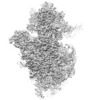

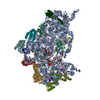



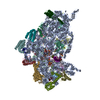


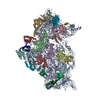
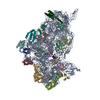





 Z (Sec.)
Z (Sec.) Y (Row.)
Y (Row.) X (Col.)
X (Col.)






























